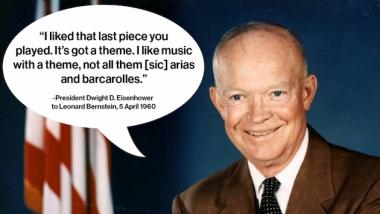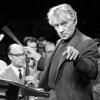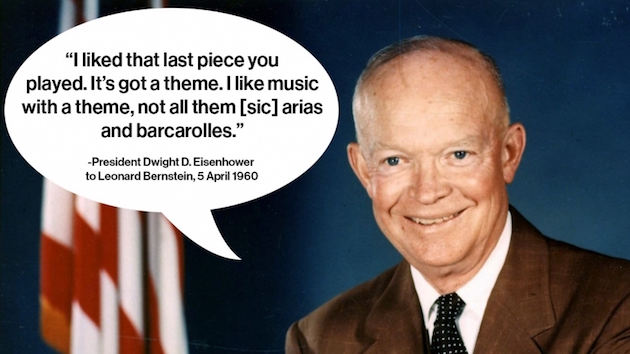
Once upon a time, in 1960 to be specific, Leonard Bernstein and President Eisenhower discussed Mozart and Gershwin in the White House. Bernstein told the story years later in an interview with Will Crutchfield of The New York Times:
“I took about 30 members of the New York Philharmonic down and played a Mozart concerto and the Rhapsody in Blue,” Bernstein recounted. “Afterward, the President said, ‘You know, I liked that last piece you played — it’s got a theme, you know what I mean?’ We didn’t know what he meant, [but] obviously, he was bored stiff by the Mozart. Finally, I said, ‘I think I know what you mean, Mr. President, it has a beat.’ ‘No,’ he said, ‘I mean a theme. I like music with a theme, not all them arias and barcarolles.’”
Heaven only knows where Ike got the word for a Venetian gondolier’s boating song to describe Mozart, but there it was, and Bernstein recalled: “Right away I noted that down as a title to use someday.”
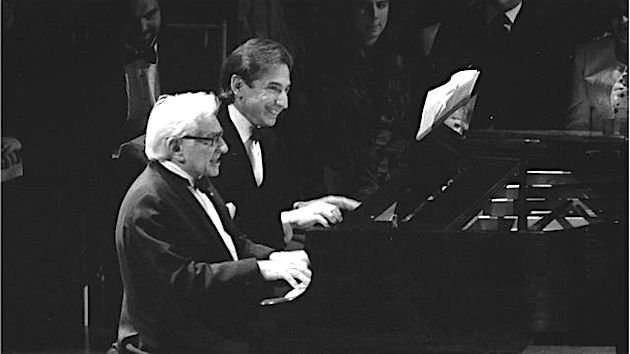
And so, the Arias and Barcarolles song cycle was born, first performed in New York in 1988, in a version for four singers (Joyce Castle, Louise Edeiken, John Brandstetter, Mordechai Kaston) and piano duet -- Bernstein and Michael Tilson Thomas. Over the years, the work had various revisions, including one by Bright Sheng for strings and percussion.
When MTT conducts it on Sept. 22–24, it will be in Bruce Coughlin’s 1993 orchestration with mezzo-soprano Isabel Leonard and bass-baritone Ryan McKinny (no pianists). These programs also include Bernstein’s Prelude, Fugue, and Riffs, Chichester Psalms, and Symphonic Dances from West Side Story.
Of Arias and Barcarolles, Bernstein’s last major piece, MTT says that, along with A Quiet Place, it shows Bernstein as a “masterful musical conjurer ... He is so amazing in transforming tone rows from angry ostinatos to scat riffs, bluesy ballads, or Mahlerian adagios. The music is so clever, yet engaging and satisfying to follow. But the essence of music and life for him was communication. His work poses questions and conundrums but also offers solutions.”
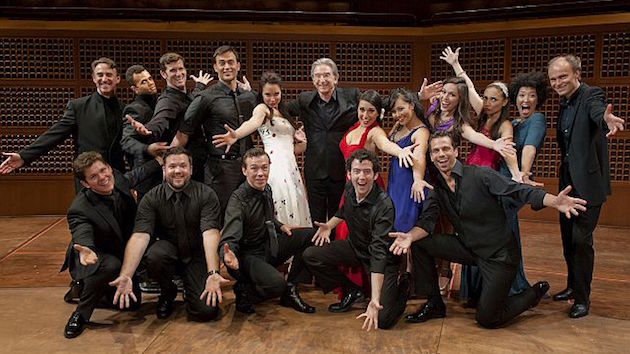
The song cycle was composed as a kind of companion piece for Brahms’s Liebeslieder Waltzes, which is also for a vocal quartet and two pianists as was the original version of Arias and Barcarolles. It is about love and relationships, the text of the songs by Bernstein, in addition to a Yiddish poem by Yankev-Yitskhok Segal, “At My Wedding,” and a bedtime story told by Bernstein’s mother.
The songs are bracketed by a Prelude and a postlude (“Nachspiel”), with the singers participating in both, although only humming at the end. This section was originally dedicated to Bernstein’s mother on her 88th birthday. (The song setting for the Segal text is dedicated to MTT.) The text of the Jennie Bernstein dedication — not included in the song cycle — is:
My First Love, Jennie B.,
Eighty-eight, young to me.
My second love is eighty-eight too.
Eighty-eight keys that sing to you...
Thus do I dedicate Eighty-eight
To my first two loves.

